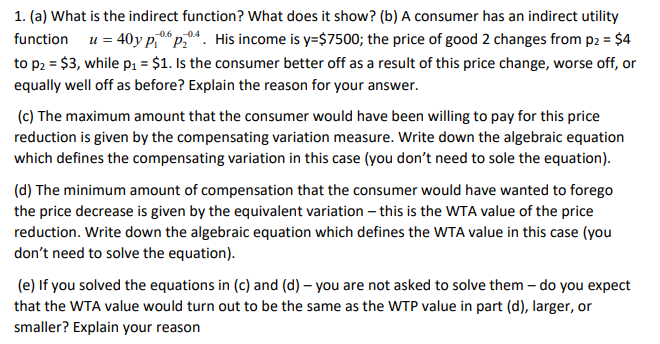-0.6 1. (a) What is the indirect function? What does it show? (b) A consumer has an indirect utility function u = 40y p6p₂4. His income is y=$7500; the price of good 2 changes from p2 = $4 to p2 = $3, while p₁ = $1. Is the consumer better off as a result of this price change, worse off, or equally well off as before? Explain the reason for your answer. (c) The maximum amount that the consumer would have been willing to pay for this price reduction is given by the compensating variation measure. Write down the algebraic equation which defines the compensating variation in this case (you don't need to sole the equation). (d) The minimum amount of compensation that the consumer would have wanted to forego the price decrease is given by the equivalent variation - this is the WTA value of the price reduction. Write down the algebraic equation which defines the WTA value in this case (you don't need to solve the equation). (e) If you solved the equations in (c) and (d) - you are not asked to solve them - do you expect that the WTA value would turn out to be the same as the WTP value in part (d), larger, or smaller? Explain your reason
-0.6 1. (a) What is the indirect function? What does it show? (b) A consumer has an indirect utility function u = 40y p6p₂4. His income is y=$7500; the price of good 2 changes from p2 = $4 to p2 = $3, while p₁ = $1. Is the consumer better off as a result of this price change, worse off, or equally well off as before? Explain the reason for your answer. (c) The maximum amount that the consumer would have been willing to pay for this price reduction is given by the compensating variation measure. Write down the algebraic equation which defines the compensating variation in this case (you don't need to sole the equation). (d) The minimum amount of compensation that the consumer would have wanted to forego the price decrease is given by the equivalent variation - this is the WTA value of the price reduction. Write down the algebraic equation which defines the WTA value in this case (you don't need to solve the equation). (e) If you solved the equations in (c) and (d) - you are not asked to solve them - do you expect that the WTA value would turn out to be the same as the WTP value in part (d), larger, or smaller? Explain your reason
Chapter3: Preferences And Utility
Section: Chapter Questions
Problem 3.7P
Related questions
Question
topic: Dorect Utility functions... i need part d and e

Transcribed Image Text:1. (a) What is the indirect function? What does it show? (b) A consumer has an indirect utility
function u = 40y p, p.4. His income is y=$7500; the price of good 2 changes from p2 = $4
-0.6 n0.4
to p2 = $3, while p1 = $1. Is the consumer better off as a result of this price change, worse off, or
equally well off as before? Explain the reason for your answer.
(c) The maximum amount that the consumer would have been willing to pay for this price
reduction is given by the compensating variation measure. Write down the algebraic equation
which defines the compensating variation in this case (you don't need to sole the equation).
(d) The minimum amount of compensation that the consumer would have wanted to forego
the price decrease is given by the equivalent variation – this is the WTA value of the price
reduction. Write down the algebraic equation which defines the WTA value in this case (you
don't need to solve the equation).
(e) If you solved the equations in (c) and (d) – you are not asked to solve them – do you expect
that the WTA value would turn out to be the same as the WTP value in part (d), larger, or
smaller? Explain your reason
Expert Solution
This question has been solved!
Explore an expertly crafted, step-by-step solution for a thorough understanding of key concepts.
Step 1: First of all we will understand what is the indirect function and what does it show?
VIEWStep 2: Let's calculate the second part:
VIEWStep 3: Let's calculate the write down the algebraic equation which defines the compensating variation:
VIEWStep 4: Let's calculate Equivalent Variation:
VIEWSolution
VIEWStep by step
Solved in 5 steps

Knowledge Booster
Learn more about
Need a deep-dive on the concept behind this application? Look no further. Learn more about this topic, economics and related others by exploring similar questions and additional content below.Recommended textbooks for you



Principles of Microeconomics (MindTap Course List)
Economics
ISBN:
9781305971493
Author:
N. Gregory Mankiw
Publisher:
Cengage Learning



Principles of Microeconomics (MindTap Course List)
Economics
ISBN:
9781305971493
Author:
N. Gregory Mankiw
Publisher:
Cengage Learning

Principles of Microeconomics
Economics
ISBN:
9781305156050
Author:
N. Gregory Mankiw
Publisher:
Cengage Learning

Principles of Economics, 7th Edition (MindTap Cou…
Economics
ISBN:
9781285165875
Author:
N. Gregory Mankiw
Publisher:
Cengage Learning

Principles of Economics (MindTap Course List)
Economics
ISBN:
9781305585126
Author:
N. Gregory Mankiw
Publisher:
Cengage Learning